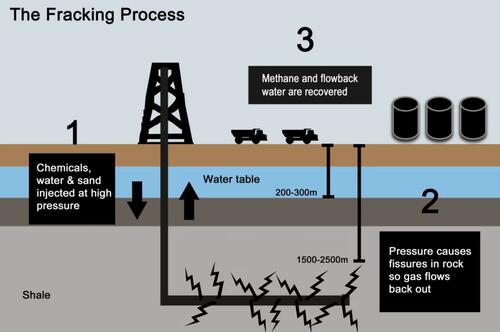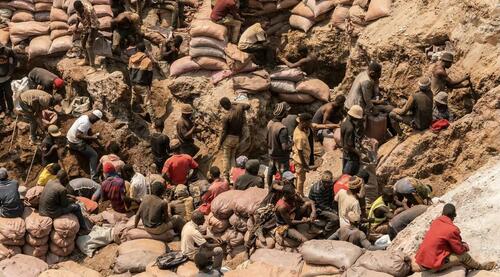The global, government-coerced transition into "green energy" has geologists scouring the Earth for new sources of lithium -- the element that's required for batteries, like those used in electric vehicles.
Now, in a cosmic practical joke on environmentalists, researchers say they've found a lithium mother lode -- in Pennsylvania fracking wastewater.
It turns out that the Marcellus Shale -- a long swath of sedimentary rock in the northeastern United States that holds huge amounts of frackable gas -- holds huge quantities of lithium too. Justin Mackey and other researchers at the National Energy Technology Laboratory in Pennsylvania were pleasantly surprise when they studied the contents of wastewater dredged up in the fracking process at 515 sites in the Keystone State, reports Science Alert.
Long before the frackers showed up, deep groundwater has been dissolving the lithium in the Marcellus Shale for eons. "It's been dissolving rocks for hundreds of millions of years—essentially, the water has been mining the subsurface," Mackey told the University of Pittsburgh's Brandie Jefferson.
When they analyzed the wastewater data, they were stunned by the volume of lithium. The shale "has the capacity to provide significant lithium yields for the foreseeable future" he says. Their detailed findings were published in Scientific Reports.
It's unclear if other fracking hotspots have abundant lithium too. However, even using conservative estimates of how much can be recovered from the wastewater suggests that Pennsylvania alone could cover more than 30% of America's 2024 demand.
The lithium rich wastewater from oil fracking in the Marcellus Shale has the potential to provide 30% of the US demand for Lithium. Unfortunately New York bans the practice of fracking for this oil & its lithium rich wastewater. https://t.co/Ry3gZJexGD
— Izengabe (@Izengabe_) May 19, 2024
The US government is targeting lithium independence, with the Department of Energy specifically aiming for all of the country's lithium needs to be covered by domestic production by 2030. That's causing a mad rush -- and conflicts that pit green energy boosters against environmentalists and American Indians who are litigating to shut down promising sources.
Case in point: the Thacker Pass mine in northern Nevada, which is supposed to be the nation's largest open-pit lithium mine. Indian tribes sued, claiming the mine is too close to the site of an 1865 massacre. Environmentalists sued, saying the mining process will destroy animal habitats and harm groundwater. Now the federal Fish and Wildlife Service is doing a year-long study on the potential impact to a tiny snail.

The United States is way behind other countries. Here's the 2023 lithium production leaderboard according to Investing News Network:
- Australia: 86,000 metric tons (MT)
- Chile: 44,000
- China: 33,000
- Argentina: 9,600
- Brazil: 4,900
- Zimbabwe: 3,400
- Canada: 3,400 (tied for 6th)
- Portugal: 380
- USA: Production numbers withheld, purportedly to protect proprietary company data

Lithium and cobalt mining in third-world countries is often a highly toxic and hazardous enterprise. In the Democratic Republic of the Congo, for example, militias have reportedly abducted children and brought them to dig away to fulfill leftists' green dreams.
Here's how Harvard's Siddharth Kara described the horror show:
"You have to imagine walking around some of these mining areas and dialing back our clock centuries. People are working in subhuman, grinding, degrading conditions. They use pickaxes, shovels, stretches of rebar to hack and scrounge at the earth in trenches and pits and tunnels to gather cobalt and feed it up the formal supply chain.
"Cobalt is toxic to touch and breathe — and there are hundreds of thousands of poor Congolese people touching and breathing it day in and day out. Young mothers with babies strapped to their backs, all breathing in this toxic cobalt dust."
Compared to that, harvesting Pennsylvania fracking wastewater sounds positively idyllic. Whatya say, Greta?
The global, government-coerced transition into "green energy" has geologists scouring the Earth for new sources of lithium -- the element that's required for batteries, like those used in electric vehicles.
Now, in a cosmic practical joke on environmentalists, researchers say they've found a lithium mother lode -- in Pennsylvania fracking wastewater.
It turns out that the Marcellus Shale -- a long swath of sedimentary rock in the northeastern United States that holds huge amounts of frackable gas -- holds huge quantities of lithium too. Justin Mackey and other researchers at the National Energy Technology Laboratory in Pennsylvania were pleasantly surprise when they studied the contents of wastewater dredged up in the fracking process at 515 sites in the Keystone State, reports Science Alert.
Long before the frackers showed up, deep groundwater has been dissolving the lithium in the Marcellus Shale for eons. "It's been dissolving rocks for hundreds of millions of years—essentially, the water has been mining the subsurface," Mackey told the University of Pittsburgh's Brandie Jefferson.
When they analyzed the wastewater data, they were stunned by the volume of lithium. The shale "has the capacity to provide significant lithium yields for the foreseeable future" he says. Their detailed findings were published in Scientific Reports.
It's unclear if other fracking hotspots have abundant lithium too. However, even using conservative estimates of how much can be recovered from the wastewater suggests that Pennsylvania alone could cover more than 30% of America's 2024 demand.
The lithium rich wastewater from oil fracking in the Marcellus Shale has the potential to provide 30% of the US demand for Lithium. Unfortunately New York bans the practice of fracking for this oil & its lithium rich wastewater. https://t.co/Ry3gZJexGD
— Izengabe (@Izengabe_) May 19, 2024
The US government is targeting lithium independence, with the Department of Energy specifically aiming for all of the country's lithium needs to be covered by domestic production by 2030. That's causing a mad rush -- and conflicts that pit green energy boosters against environmentalists and American Indians who are litigating to shut down promising sources.
Case in point: the Thacker Pass mine in northern Nevada, which is supposed to be the nation's largest open-pit lithium mine. Indian tribes sued, claiming the mine is too close to the site of an 1865 massacre. Environmentalists sued, saying the mining process will destroy animal habitats and harm groundwater. Now the federal Fish and Wildlife Service is doing a year-long study on the potential impact to a tiny snail.

The United States is way behind other countries. Here's the 2023 lithium production leaderboard according to Investing News Network:
- Australia: 86,000 metric tons (MT)
- Chile: 44,000
- China: 33,000
- Argentina: 9,600
- Brazil: 4,900
- Zimbabwe: 3,400
- Canada: 3,400 (tied for 6th)
- Portugal: 380
- USA: Production numbers withheld, purportedly to protect proprietary company data

Lithium and cobalt mining in third-world countries is often a highly toxic and hazardous enterprise. In the Democratic Republic of the Congo, for example, militias have reportedly abducted children and brought them to dig away to fulfill leftists' green dreams.
Here's how Harvard's Siddharth Kara described the horror show:
"You have to imagine walking around some of these mining areas and dialing back our clock centuries. People are working in subhuman, grinding, degrading conditions. They use pickaxes, shovels, stretches of rebar to hack and scrounge at the earth in trenches and pits and tunnels to gather cobalt and feed it up the formal supply chain.
"Cobalt is toxic to touch and breathe — and there are hundreds of thousands of poor Congolese people touching and breathing it day in and day out. Young mothers with babies strapped to their backs, all breathing in this toxic cobalt dust."
Compared to that, harvesting Pennsylvania fracking wastewater sounds positively idyllic. Whatya say, Greta?

